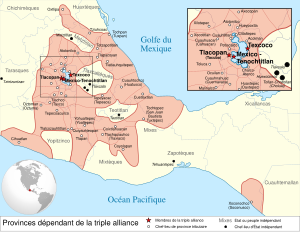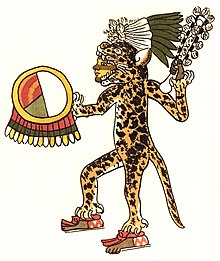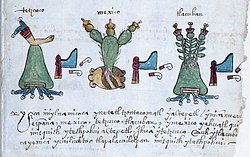Aztec Empire
- This article refers to an alliance of three Aztec city-states. For other alliances of three parties, see Triple Alliance (disambiguation).
This article needs additional citations for verification. (January 2007) |
Aztec Triple Alliance Mēxihcatlahtohcāyōtl | |||||||
|---|---|---|---|---|---|---|---|
| 1325–1521 | |||||||
|
Middle section of page 34 of Codex Osuna, from 1565, showing the pictorial symbols for Texcoco, Tenochtitlan, and Tlacopan. | |||||||
 | |||||||
| Capital | Tenōchtitlan | ||||||
| Common languages | Nahuatl | ||||||
| Religion | Aztec religion | ||||||
| Government | Hegemonic empire | ||||||
| Tlatoani | |||||||
• 1376–1395 | Acamapichtli | ||||||
• 1520–1521 | Cuauhtémoc | ||||||
| Historical era | Pre-Columbian | ||||||
• Founding of Tenochtitlan | March 13, 1325 1325 | ||||||
| August 13, 1521 1521 | |||||||
| Area | |||||||
| 500,000 km2 (190,000 sq mi) | |||||||
| Currency | Various currencies | ||||||
| |||||||
The Aztec Triple Alliance, also known as the Aztec Empire, was an alliance of three Aztec city-states: Tenochtitlan; Texcoco; and Tlacopan. These city-states ruled the area in and around the Valley of Mexico from 1428 until they were defeated by the Spanish conquistadores and their native allies under Hernán Cortés in 1521.
The Aztec Triple Alliance was formed by Itzcoatl of Tenochtitlan, Acolhuacans of Texcoco, and the smaller city-state of Tlacopan in 1428. Despite the name, Tenochtitlan was the dominant partner, and Tlacopan the weakest. Tenochtitlan and Texcoco each received 2/5 of all tribute, and Tlacopan received 1/5. By the time the Spanish arrived in 1520, Tlacopan had nearly disappeared as a separate city-state, and the lands of the Alliance were ruled from Tenochtitlan.
At its height, the Alliance controlled most of central Mexico from coast to coast, except for a small area southeast of Tenochtitlan: the Kingdom of the Tlaxcalteca, roughly bounded by the modern-day Mexican state of Tlaxcala. It was the Tlaxcalans who allied with Cortés in 1521 to ultimately destroy the Alliance.
 |
| Aztec Empire |
|---|
Aztec empire
The Aztec empire was a tribute empire based in Tenochtitlan, which extended its power throughout Mesoamerica in the late postclassic period. It originated in 1427 as a Triple alliance between the city-states Tenochtitlan, Texcoco and Tlacopan who allied to defeat the Tepanec state of Azcapotzalco, that had previously dominated the Basin of Mexico. Soon Texcoco and Tlacopan became junior partners in the alliance which was de-facto lead by the Mexica of Tenochtitlan. The empire extended its power by a combination of trade and military conquest. It was never a true territorial empire controlling a territory by large military garrisons in conquered provinces, but rather controlled its client states primarily by installing friendly rulers in conquered cities or constructing marriage alliances between the ruling dynasties, and by extending an imperial ideology to its client states. Client states paid tribute to the Aztec emperor, the Huey Tlatoani in an economic strategy limiting communication and trade between outlying polities making them depend on the imperial center for the acquisition of luxury goods. The political clout of the empire reached far south into Mesoamerica conquering cities as far south as Chiapas and Guatemala and spanning from the pacific to the atlantic oceans. The empire reached its maximal extent in 1519 just prior to the arrival of the Spanish conquistadors led by Cortés who managed to topple the Aztec empire by allying with some of the traditional enemies of the Aztecs, the Nahuatl speaking Tlaxcalteca.

Rise of the Triple Alliance

The true origin of the Mexicas is uncertain. According to their legends, the Mexica tribe place of origin was Aztlán. It is generally thought that Aztlán was somewhere to the north of the Valley of Mexico; some experts have placed it as far north as Southwestern United States.
Based on these codices as well as other histories, it appears that the Mexicas arrived at Chapultepec in or around the year 1248.
At the time of their arrival, the Valley of Mexico had many city-states, the most powerful of which were Culhuacan to the south and Azcapotzalco to the west. The Tepanecs of Azcapotzalco soon expelled the Mexicas from Chapultepec. In 1299, Culhuacan ruler Cocoxtli gave them permission to settle in the empty barrens of Tizapan, where they were eventually assimilated into Culhuacan culture.
In 1323, the Mexicas were shown a vision of an eagle perched on a prickly pear cactus, eating a snake. This vision indicated that this was the location where they were to build their home. In any event, the Mexicas eventually arrived on a small swampy island in Lake Texcoco where they founded the town of Tenochtitlan in 1325. In 1376, the Mexicas elected their first Huey Tlatoani, Acamapichtli, who was living in Texcoco at the time.
For the next 50 years, until 1427, the Mexica were a tributary of Azcapotzalco, which had become a regional power, perhaps the most powerful since the Toltecs, centuries earlier. Maxtla, son of Tezozomoc, assassinated Chimalpopoca, the Mexica ruler. In an effort to defeat Maxtla, Chimalpopoca's successor, Itzcoatl, allied with the exiled ruler of Texcoco, Nezahualcoyotl. This coalition was the foundation of the Aztec Triple Alliance, which defeated Azcapotzalco in 1428.

The Triple Alliance of Tenochtitlan, Texcoco, and Tlacopan would, in the next 100 years, come to dominate the Valley of Mexico and extend its power to both the Gulf of Mexico and the Pacific shore. Over this period, Tenochtitlan gradually became the dominant power in the alliance.
Two of the primary architects of the Aztec empire were the half-brothers Tlacaelel and Montezuma I, nephews of Itzcoatl. Moctezuma I succeeded Itzcoatl as Hueyi Tlatoani in 1440. Although he was also offered the opportunity to be tlatoani, Tlacaelel preferred to operate as the power behind the throne. Tlacaelel reformed the Aztec state and religion. According to some sources, he ordered the burning of most of the extant Aztec books claiming that they contained lies. He thereupon rewrote the history of the Aztec people, thus creating a common awareness of history for the Aztecs. This rewriting led directly to the curriculum taught to scholars and promoted the belief that the Aztecs were always a powerful and mythic nation; forgetting forever a possible true history of modest origins. One component of this reform was the institution of ritual war (the flower wars) as a way to have trained warriors, and created the necessity of constant sacrifices to keep the Sun moving.
Spanish conquest & Aztec deafeat
The empire reached its height during Ahuitzotl's reign in 1486–1502. His successor, Motehcuzōma Xocoyotzin (better known as Moctezuma II or Moctezuma), had been Hueyi Tlatoani for 17 years when the Spaniards, led by Hernándo Cortés, landed on the Gulf Coast in the spring of 1519.
Despite some early battles between the two, Cortés allied himself with the Aztecs’ long-time enemy, the Confederacy of Tlaxcala, and arrived at the gates of Tenochtitlan on November 8, 1519.
The Spaniards and their Tlaxcallan allies became increasingly dangerous and unwelcome guests in the capital city. In June, 1520, hostilities broke out, culminating in the massacre in the Main Temple and the death of Moctezuma II. The Spaniards fled the town on July 1, an episode later characterized as La Noche Triste (the Sad Night). They and their native allies returned in the spring of 1521 to lay siege to Tenochtitlan, a battle that ended on August 13 with the destruction of the city. During this period the now crumbling empire went through a rapid line of ruler succession. After the death of Moctezuma II, the empire fell into the hands of severely weakened emperors, such as Cuitláhuac, before eventually being ruled by puppet rulers, such as Andrés de Tapia Motelchiuh, installed by the Spanish.
Despite the decline of the Aztec empire, most of the Mesoamerican cultures were intact after the fall of Tenochtitlan. Indeed, the freedom from Aztec domination may have been considered a positive development by most of the other cultures. The upper classes of the Aztec empire were considered noblemen by the Spaniards and generally treated as such initially. All this changed rapidly and the native population were soon forbidden to study by law, and had the status of minors[citation needed].
The Tlaxcalans remained loyal to their Spanish friends and were allowed to come on other conquests with Cortés and his men.

